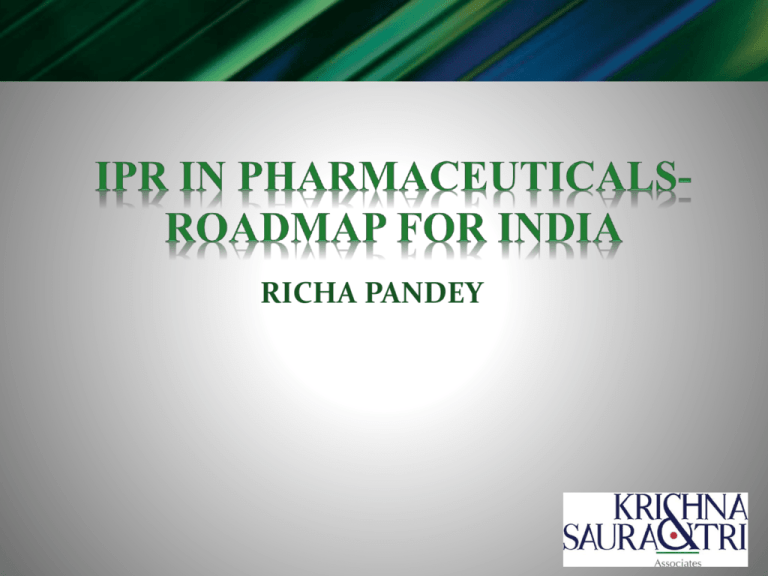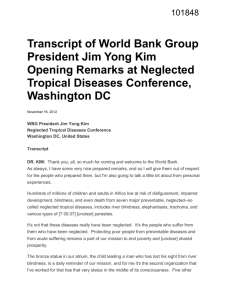CHALLENGES AND CURRENT POSITION OF PATENTS IN INDIA
advertisement

RICHA PANDEY Trademark – Brand Names (Crocin) Design – Shape/packaging Copyright – labels (look & feel) Patents o India became a member of WTO/TRIPS Agreement effective, January 01, 1995 o India was given ten years’ transition period to fully comply with TRIPS o This was done in three stages effective: o January 01, 1995 • • o May 20, 2003 • o Filing of Black-Box applications Provision for Exclusive Marketing Rights Uniform patent term of 20 years January 01, 2005 • Grant of product patents in all fields of technology including drugs, food and chemical substances. 3 (c) the mere discovery of a scientific principle or the formulation of an abstract theory or discovery of any living thing or non-living substance occurring in nature. Funk Bros. Seed Co Vs Kalo Inoculants Co. 75 USPQ 280 (1948) Mixture of six strains of bacteria packaged to be used to inoculate leguminous plants. The Supreme Court held that the mixture of the already existing bacteria is not patentable but a mere discovery of nature 4 Section 3(d): KNOWN SUBSTANCE Mere discovery of a new form of a known substance which does not result in the enhancement of the known efficacy of that substance or mere discovery of any new property or new use for a known substance or of mere use of a known process, machine or apparatus unless such known process results in a new product or employs at least one new reactant. SAME SUBSTANCE Unless they differ significantly in properties with regard to efficacy 5 The Apex court observed – “In whatever way therapeutic efficacy may be interpreted, this much is absolutely clear: that the physico-chemical properties of beta crystalline form of Imatinib Mesylate, namely (i) more beneficial flow properties, (ii) better thermodynamic stability, and (iii) lower hygroscopicity, may be otherwise beneficial but these properties cannot even be taken into account for the purpose of the test of section 3(d) of the Act, since these properties have nothing to do with therapeutic efficacy”. KRISHNA & SAURASTRI ASSOCIATES 6 Section 3(e) “A substance obtained by mere admixture resulting only in the aggregation of the properties of the components thereof or a process for producing such substances.” How to overcome: - By establishing synergism; - By incorporating a broad range of the quantity of the ingredients in the main claim, preferably as ratio/percentages (w/w); - Technical affidavit having comparative data establishing synergism, if necessary. 7 (h) a method of agriculture or horticulture. (i) any process for the medicinal, surgical, curative, prophylactic [diagnostic, therapeutic] or other treatment of human beings or any process for a similar treatment of animals to render them free of disease or to increase their economic value or that of their products; 8 (j) plants and animals in whole or any part thereof other than micro organisms but including seeds, varieties and species and essentially biological processes for production or propagation of plants and animals; 9 What if your invention falls within these boundaries??? The biological material shall be deposited at a Depository Authority under Budapest Treaty if it is not commonly available to the public. The source and geographical origin of the biological material is to be disclosed in the specification. Necessary permission is to be sought from National Biodiversity Authority if a biological material is used from India. 11 Buruli Ulcer Chagas disease (American trypanosomiasis) Cysticercosis or Taeniasis Dengue/dengue hemorrhagic fever Dracunculiasis or guinea-worm disease Echinococcosis Endemic treponematoses (Yaws) Foodborne trematode infections Clonorchiasis Opistorchiasis Human African trypanosomiasis Leishmaniasis Leprosy Lymphatic filariasis Onchocerciasis Rabies Schistosomiasis Soil transmitted helminthiasis Trachoma Podoconiosis Snakebite Hydatid disease or Echinococcosis African Sleeping Sickness • Leprosy • Dengue • Japanese encephalitis • Chikungunya • Soil transmitted helminthiasis • Lymphatic Filariasis • Amebiasis • Rabies • Leishmaniasis Worldwide Patent Filings for Neglected Tropical Diseases 2500 2229 2000 1500 1074 1000 940 919 597 578 573 555 513 500 268 248 218 172 136 135 97 0 Neglected Tropical Diseases 96 87 81 56 47 33 28 18 16 12 10 Indian Filings for Neglected Tropical Diseases 50 45 45 40 35 30 25 20 28 21 17 15 15 10 5 6 6 6 4 0 Neglected Tropical Diseases 2 2 2 2 1 1 Comparative Analysis- Patent Filings Worldwide vs. India Endemic Treponemiasis Dracunculiasis guinea-worm… Paragonimiasis Trichuriasis Trematodiasis Buruli Ulcer Clonorchiasis Hookworm infection Tropical Disease Type Fascioliasis Amebiasis Onchocerciasis Cysticercosis or Taeniasis Ascariasis Lymphatic filariasis Hydatidosis Leptospirosis Chikungunya Helminthiasis Trypanosomiasis Rabies Schistosomiasis Chagas disease Trachoma Leishmaniasis Japanese encephalitis Leprosy Dengue Worldwide Filings vs. Indian Filings The above three charts depict patent filings relating to neglected tropical diseases and the comparative analysis of the same worldwide vis-a- vis India. It is seen that, w.r.t worldwide filings, there is more research focus on diseases like Dengue Leprosy, Japanese encephalitis, Leishmaniasis Trachoma, Chagas disease, Schistosomiasis Rabies, and Trypanosomiasis. In reference to the Indian filings, more focus is on diseases like Dengue, Leishmaniasis, Japanese encephalitis, Rabies and Chikungunya. Overall Patenting Trend 4000 3706 3500 Patent Count 3000 2500 2000 1313 1500 1018 1000 500 2 3 2 55 1921-1930 1931-1940 1941-1950 1951-1960 139 177 1961-1970 1971-1980 267 0 1981-1990 1991-2000 2001-2010 2011-2015 Priority Years Overall patenting trend shows that maximum no. of patent applications in the area of neglected tropical diseases have been filed between 2001-2010 worldwide. Patenting Trend in India 600 484 Patent Count 500 400 300 200 100 3 5 1971-1980 1981-1990 36 31 0 1991-2000 Priority Years 2001-2010 2011-2015 Patenting trend in India also shows that maximum no. of patent applications have been filed between the same decade i.e 2001-2010 in India. The patenting activity in the area of compositions and methods for treating neglected tropical diseases has shown a drastic rise after 1991 onwards. The patenting trend for the same has increased to about 55% after year 2000. Analysis based on Top 10 Priority Countries -Worldwide 3500 3244 3000 Patent Count 2500 2000 1500 1000 776 404 500 220 203 196 172 160 121 118 AU JP BR DE FR WO RU 0 US CN GB Priority Countries In the worldwide priority country distribution, United States tops the chart depicting around 58% priority filings in the areas of Tropical diseases, followed by China. Analysis based on Top 10 Priority Countries- India 400 350 339 Patent Count 300 250 200 150 100 49 50 33 26 14 12 11 10 7 7 AU DE DK WO CU NA 0 US EP GB IN Priority Countries In the priority country distribution for India, United States tops the chart , followed by European Union countries. Analysis based on Top 10 Application Countries- Worldwide 1400 1298 1200 Patent Count 1000 904 870 800 688 589 600 559 400 266 222 204 190 CA GB JP 200 0 US WO CN EP AU IN SG Application Countries With reference to the Application country analysis, is can be depicted that around 22% applications show United States as the Application country, followed by around 16% applications having PCT filings and China respectively. Top 5 International Patent Classification (IPCs) 15% 23% 19% A61K003900 A61P003500 23% A61P003112 A61K003912 20% Patent applications classified under IPC A61K003900, A61P003500 and A61P003112 are maximum in number. A61P002900 A61K003900 Medicinal preparations containing antigens or antibodies (materials for immunoassay) A61P003500 Antineoplastic agents A61P003112 Antivirals A61K003912 Medicinal preparations containing antigens or antibodies (materials for immunoassay Lipids; Lipoproteins A61P002900 Non-central analgesic, antipyretic or Anti-inflammatory agents Prolific Assignees Merck & Co Inc 7% 6% 22% Sanofi- Aventis 8% Smithkline Beecham Biologicals/ Glaxo Groups 8% Pasteur Institute 12% Pfizer Products Inc. 8% Abbvie Inc 11% 9% Abbott Laborataries 9% University of California Novartis AG Gilead Sciences Inc Merck & Co Inc., Sanofi- Aventis, Glaxo Smithkline Beecham Biologicals, Pasteur Institute and Pfizer Products Inc. are the most prolific Assignees working in the area of Neglected Tropical Diseases. Top 5 Assignees- vs. Application Years 60 50 57 46 Merck & Co Inc 55 46 Sanofi- Aventis 39 Patent Count 40 33 30 25 25 25 Smithkline Beecham Biologicals/ Glaxo Groups 23 20 13 10 10 5 10 10 14 12 6 6 13 Pasteur Institute 8 5 2 0 1961-1970 1971-1980 1981-1990 1991-2000 2001-2010 2011-2015 Pfizer Products Inc. Application Years • Merck Inc and Pfizer Inc are seen active in the area of neglected tropical diseases since 1961 onwards. Comparative activity however dropped over the last decade. • Patenting activity of Glaxo Smithkline and Sanofi-Aventis has increased during the last 15 years i.e after 2000 onwards. Top 5 Assignees vs Priority Country Coverage Merck & Co Inc 140 124 Sanofi- Aventis 120 Smithkline Beecham Biologicals/ Glaxo Groups Pasteur Institute 100 54 80 42 60 42 35 10 26 191 40 20 5 GB 4 EP 18 2 1 0 US 13 AU 1 6 DE 1 3 24 1 1 1 4 WO 26 2 1 1 IE FR HU 1 JP 2 KR 1 1 1 SG CR 1 1 IT CA 1 CN Priority Country Coverage • Most of the Assignees have United States as their priority country. • Country coverage of Sanofi-Aventis appears to be wide spread even though their filings are comparatively lesser than Merck Inc. The patenting trend has increased to about 55% post 2000. Indian Pharmaceuticals can focus more on neglected diseases like: • Leprosy • Chagas disease • Amebiasis • Hookworm infection • Helminthiasis • Leptospirosis • Trematodiasis • Trachoma • Trypanosomiasis • Schistosomiasis • Lymphatic filariasis, etc United States tops in priority country as well as application country wise filings. IPC- A61K003900 relating to Medicinal preparations containing antigens or antibodies (materials for immunoassay holds more no. of patents. Merck & Co Inc., Sanofi- Aventis, Glaxo Smithkline Beecham Biologicals, Pasteur Institute and Pfizer Products Inc. are the most prolific Assignees working in the area of Neglected Tropical Diseases. The above findings suggest that the Indian generic companies can find out the grey areas relating to various neglected diseases. Identify prevalence of such diseases in India and worldwide and focus their research on compositions and methods of treating these neglected diseases. Drug Company Acquired/Licensed from Atorvastatin Pfizer Parke Davis Infliximab J & J, Merck,Mitsubishi Tanabe Pharma New York University School of Medicine and developed by Centocor (Jansenn) Rituximab Roche & others IDEC Pharmaceuticals Oxaliplatin outlicensed to Sanofi Aventis inlicensed by Debiopharm from Nagoya City University Fasudil HCL CoTherix Inlicensed from Asahi Kasei Carisbamate Johnson & Johnson in-licensed from SK Corp Product Originator Licensee Sub-Licensee Quad Gilead Sciences Inc. HuperzineA GBR 500 Debiopharm Group MPP - sublicensed to Shasun Pharmaceuticals Ltd. Shilpa Medicare Ltd., Hetero Labs Ltd., Aurobindo Pharma Ltd. Shasun Pharma (commercialization) Glenmark Sanofi (Co development) SITAGLIPTI Merck N Sun- (commercialization) Abacavir MPP- sublicensed to Aurobindo Pharma Ltd. ViiV Healthcare MPP- Medicines Patent Pool DISCLAIMER: We have taken utmost care and diligent effort to keep the search conducted thorough amongst the leading databases, which however is non-exhaustive. The landscape report is based on the available bibliographic data amongst the leading patent databases and no technical analysis is involved in this report. THANK YOU




